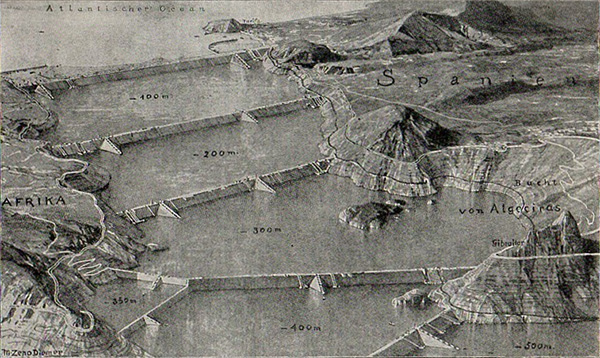
The 1920s were a time of great lows and tremendous highs. The specter of the Great War hung like a shadow over Europe, and financial ruin imposed by said war engulfed the belligerents (the United States being the lone exception). Adding to the calamity, Europe’s empires were wheezing under the weight of their colonies.
It is perhaps because of all that gloom that some people turned towards breathlessly optimistic ideas. After all, it was an age of wonder in many ways. Aeroplanes and dirigibles drifted and swooped from city to city and continent to continent. The Industrial Revolution had firmly cemented itself throughout the Western world, producing a surfeit of landmarks to human progress. Many big thinkers were dreaming up dams and skyscrapers and subways of unimaginable scale for the time. But one man was busy out-thinking the rest. Herman Sörgel had a plan so grand that it would have changed the face of the Earth.
Sörgel was a German architect living in Munich. A follower of the Bauhaus school, he did not produce any notable architectural works in his lifetime. Instead, he is remembered for devising an audacious plan to dam the Strait of Gibraltar and lower the Mediterranean Sea by 200 meters. Known as Atlantropa, the project would have generated enormous amounts of electricity, irrigated much of the Northern Africa (though how the water would be desalinated is unclear), flooded the heart of the African continent, and exposed over 250,000 square miles (660,000 square kilometers) of land in a bathtub ring around the Mediterranean.
Atlantropa had a solution for every European problem. Feeling crowded? The plan would add another France and Austria’s worth of land. Need more electricity? Various dams would have generated 365,000 megawatts of power by some estimates. Short on food? Just import it from the new African breadbasket, now a mere train shipment away.
There were, however, numerous problems that Sörgel overlooked. Workaday harbor towns would have been left high and dry. Dropping the Mediterranean Sea by 200 meters would have drastically altered its ecosystem, and the flooding of Africa would have inundated some world’s most diverse forests. Local climate regimes would have almost certainly changed in unpredictable ways. The plan also reflected the decidedly colonial and Euro-centric attitudes of the times. The proposed Saharan breadbasket may seem noble at first blush, but flooding central Africa in the process smacks of indifference. But perhaps Sörgel’s most glaring oversight was, how would they pay for it all? Europe was flat broke following World War I, and many countries would have had to work together to see it through. Such tight international cooperation is elusive even in today’s relatively peaceful times.
At its heart, the Atlantropa plan seems to be a reaction to the continent’s crowded landscape and thinning resources. Land was in short supply, mineral wealth was being mined at a rapid pace, and energy sources were hotly contested. The losers of the Great War—Germany among them—were in a deeper hole, having lost both territory on the continent and their colonies abroad. Sörgel hoped his massive project would change all that, ending resource shortages and bringing Europe and Africa together. Sörgel felt Europe could not compete with the land- and resource-rich continents of Asia and the Americas unless something drastic was done. His solution embodied a simple, if flawed, maxim: If you can’t import resources from faraway lands, bring the land needed to you. Sörgel’s fatal error, though, was the plan’s sheer scale. Securing resources for Europe’s future required spending a continent’s worth of resources today. Ultimately, Atlantropa was little better than a perpetual motion machine.
Sources and other links:
Edit Suisse Group. “Atlantropa.” Cabinet Magazine, Spring 2003.
Ptak, John F. 2011. “A Monumental and Fantastically Bad Idea: Draining the Mediterranean.” Ptak Science Books.
Jacobs, Frank. 2008. “Dam You, Mediterranean: The Atlantropa Project.” Big Think.
Morales, Michel. 2005. “Atlantropa: Der Traum vom neuen Kontinent.” TV documentary, German. (Parts 1, 2, 3, 4, 5, and 6 on YouTube.)